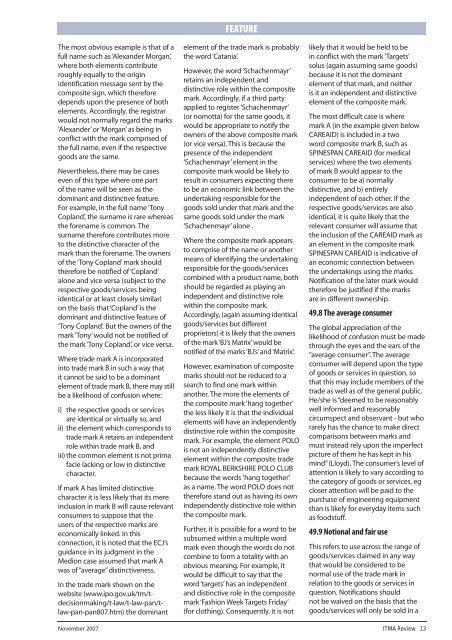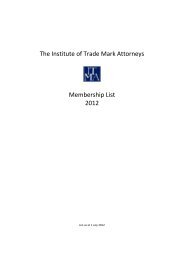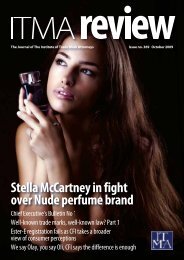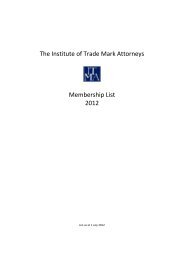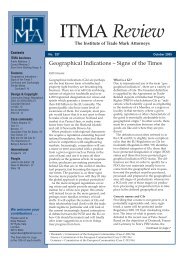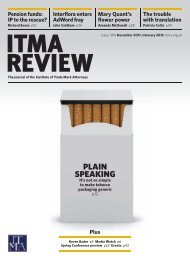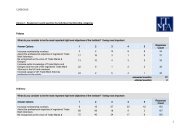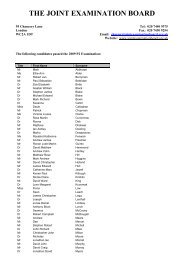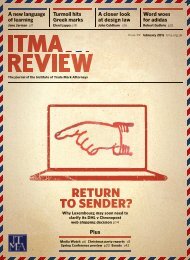ITMA Autumn Conference: Treviso provides cultured backdrop for ...
ITMA Autumn Conference: Treviso provides cultured backdrop for ...
ITMA Autumn Conference: Treviso provides cultured backdrop for ...
You also want an ePaper? Increase the reach of your titles
YUMPU automatically turns print PDFs into web optimized ePapers that Google loves.
The most obvious example is that of a<br />
full name such as ‘Alexander Morgan’,<br />
where both elements contribute<br />
roughly equally to the origin<br />
identification message sent by the<br />
composite sign, which there<strong>for</strong>e<br />
depends upon the presence of both<br />
elements. Accordingly, the registrar<br />
would not normally regard the marks<br />
‘Alexander’ or ‘Morgan’ as being in<br />
conflict with the mark comprised of<br />
the full name, even if the respective<br />
goods are the same.<br />
Nevertheless, there may be cases<br />
even of this type where one part<br />
of the name will be seen as the<br />
dominant and distinctive feature.<br />
For example, in the full name ‘Tony<br />
Copland’, the surname is rare whereas<br />
the <strong>for</strong>ename is common. The<br />
surname there<strong>for</strong>e contributes more<br />
to the distinctive character of the<br />
mark than the <strong>for</strong>ename. The owners<br />
of the ‘Tony Copland’ mark should<br />
there<strong>for</strong>e be notified of ‘Copland’<br />
alone and vice versa (subject to the<br />
respective goods/services being<br />
identical or at least closely similar)<br />
on the basis that ‘Copland’ is the<br />
dominant and distinctive feature of<br />
‘Tony Copland’. But the owners of the<br />
mark ‘Tony’ would not be notified of<br />
the mark ‘Tony Copland’, or vice versa.<br />
Where trade mark A is incorporated<br />
into trade mark B in such a way that<br />
it cannot be said to be a dominant<br />
element of trade mark B, there may still<br />
be a likelihood of confusion where:<br />
i) the respective goods or services<br />
are identical or virtually so, and<br />
ii) the element which corresponds to<br />
trade mark A retains an independent<br />
role within trade mark B, and<br />
iii) the common element is not prima<br />
facie lacking or low in distinctive<br />
character.<br />
If mark A has limited distinctive<br />
character it is less likely that its mere<br />
inclusion in mark B will cause relevant<br />
consumers to suppose that the<br />
users of the respective marks are<br />
economically linked. In this<br />
connection, it is noted that the ECJ’s<br />
guidance in its judgment in the<br />
Medion case assumed that mark A<br />
was of “average” distinctiveness.<br />
In the trade mark shown on the<br />
website (www.ipo.gov.uk/tm/tdecisionmaking/t-law/t-law-pan/tlaw-pan-pan807.htm)<br />
the dominant<br />
November 2007<br />
FEATURE<br />
element of the trade mark is probably<br />
the word ‘Catania’.<br />
However, the word ‘Schachenmayr’<br />
retains an independent and<br />
distinctive role within the composite<br />
mark. Accordingly, if a third party<br />
applied to register ‘Schachenmayr’<br />
(or nomotta) <strong>for</strong> the same goods, it<br />
would be appropriate to notify the<br />
owners of the above composite mark<br />
(or vice versa). This is because the<br />
presence of the independent<br />
‘Schachenmayr’ element in the<br />
composite mark would be likely to<br />
result in consumers expecting there<br />
to be an economic link between the<br />
undertaking responsible <strong>for</strong> the<br />
goods sold under that mark and the<br />
same goods sold under the mark<br />
‘Schachenmayr’ alone .<br />
Where the composite mark appears<br />
to comprise of the name or another<br />
means of identifying the undertaking<br />
responsible <strong>for</strong> the goods/services<br />
combined with a product name, both<br />
should be regarded as playing an<br />
independent and distinctive role<br />
within the composite mark.<br />
Accordingly, (again assuming identical<br />
goods/services but different<br />
proprietors) it is likely that the owners<br />
of the mark ‘BJ’s Matrix’ would be<br />
notified of the marks ‘BJ’s’ and ‘Matrix’.<br />
However, examination of composite<br />
marks should not be reduced to a<br />
search to find one mark within<br />
another. The more the elements of<br />
the composite mark ‘hang together’<br />
the less likely it is that the individual<br />
elements will have an independently<br />
distinctive role within the composite<br />
mark. For example, the element POLO<br />
is not an independently distinctive<br />
element within the composite trade<br />
mark ROYAL BERKSHIRE POLO CLUB<br />
because the words ’hang together’<br />
as a name. The word POLO does not<br />
there<strong>for</strong>e stand out as having its own<br />
independently distinctive role within<br />
the composite mark.<br />
Further, it is possible <strong>for</strong> a word to be<br />
subsumed within a multiple word<br />
mark even though the words do not<br />
combine to <strong>for</strong>m a totality with an<br />
obvious meaning. For example, it<br />
would be difficult to say that the<br />
word ‘targets’ has an independent<br />
and distinctive role in the composite<br />
mark ‘Fashion Week Targets Friday’<br />
(<strong>for</strong> clothing). Consequently, it is not<br />
likely that it would be held to be<br />
in conflict with the mark ‘Targets’<br />
solus (again assuming same goods)<br />
because it is not the dominant<br />
element of that mark, and neither<br />
is it an independent and distinctive<br />
element of the composite mark.<br />
The most difficult case is where<br />
mark A (in the example given below<br />
CAREAID) is included in a two<br />
word composite mark B, such as<br />
SPINESPAN CAREAID (<strong>for</strong> medical<br />
services) where the two elements<br />
of mark B would appear to the<br />
consumer to be a) normally<br />
distinctive, and b) entirely<br />
independent of each other. If the<br />
respective goods/services are also<br />
identical, it is quite likely that the<br />
relevant consumer will assume that<br />
the inclusion of the CAREAID mark as<br />
an element in the composite mark<br />
SPINESPAN CAREAID is indicative of<br />
an economic connection between<br />
the undertakings using the marks.<br />
Notification of the later mark would<br />
there<strong>for</strong>e be justified if the marks<br />
are in different ownership.<br />
49.8 The average consumer<br />
The global appreciation of the<br />
likelihood of confusion must be made<br />
through the eyes and the ears of the<br />
“average consumer”. The average<br />
consumer will depend upon the type<br />
of goods or services in question, so<br />
that this may include members of the<br />
trade as well as of the general public.<br />
He/she is “deemed to be reasonably<br />
well in<strong>for</strong>med and reasonably<br />
circumspect and observant - but who<br />
rarely has the chance to make direct<br />
comparisons between marks and<br />
must instead rely upon the imperfect<br />
picture of them he has kept in his<br />
mind” (Lloyd). The consumer’s level of<br />
attention is likely to vary according to<br />
the category of goods or services, eg<br />
closer attention will be paid to the<br />
purchase of engineering equipment<br />
than is likely <strong>for</strong> everyday items such<br />
as foodstuff.<br />
49.9 Notional and fair use<br />
This refers to use across the range of<br />
goods/services claimed in any way<br />
that would be considered to be<br />
normal use of the trade mark in<br />
relation to the goods or services in<br />
question. Notifications should<br />
not be waived on the basis that the<br />
goods/services will only be sold in a<br />
<strong>ITMA</strong> Review 13


